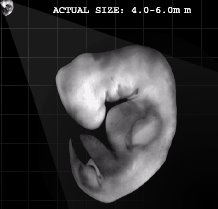This is a pretty busy and important time for the little embryo. All of this hidden activity kind of explains why I need to go to bed early these days. It is all just SO fascinating!
From Visembryo:
approximately 27-29 postovulatory days
 Four Limb Buds, Lens Disc and Optic Vesicle, the first thin surface layer of skin appears covering the embryo. Between thirty and forty somite pairs.
Four Limb Buds, Lens Disc and Optic Vesicle, the first thin surface layer of skin appears covering the embryo. Between thirty and forty somite pairs.Head and Neck Region
The brain differentiates into the three main parts: the forebrain, midbrain and hindbrain. The forebrain consists of lobes that translate input from the senses, and will be responsible for memory formation, thinking, reasoning, problem solving. The midbrain will serve as a relay station, coordinating messages to their final destination. The hindbrain will be responsible for regulating the heart, breathing and muscle movements.Thyroid continues to develop and the lymphatic system, which filters out bacteria, starts to form.
Otic placode invaginates and forms the otic vesicle, which will develop into the structures needed for hearing and maintenance of equilibrium.
Retinal disc presses outward and touches the surface ectoderm. In response the ectoderm proliferates forming the lens disc. Specific parts of the eye, such as the retina, the future pigment of the retina and the optic stalk are identifiable.
Primitive mouth with a tongue is recognizable.
Thyroid continues to develop and the lymphatic system, which filters out bacteria, starts to form.
Thorax
Heart chambers are filled with plasma and blood cells making the heart seem distended and prominent. The heart and liver combined are equal in volume to the head by this stage. Blood circulation is well established, though true valves are not yet present.. The villous network is in place to accommodate the exchange of blood between the woman and the embryo. Aortic arches 4 and 6 develop and 5 may appear.
Lung buds continue to form.
Abdomen and Pelvic Regions
Gall bladder, stomach, intestines, pancreas continue to form and the metanephric bud appears in the chest cavity. The stomach is in the shape of a spindle and the pancreas may be detected at the intestinal tube.
The developing liver receives blood from the placenta via the umbilical cord.
The amnion encloses the connecting stalk helping to fuse it with the longer and more slender umbilical vesicle (the remnant of the yolk sac).
Limbs
Upper limb buds are visible as ridges and the lower limb buds begin to develop. Folding is complete and the embryo is now three-dimensional and is completely enclosed in the amniotic sac. The somites will be involved in building bones and muscles. The first thin surface layer of skin appears covering the embryo.

No comments:
Post a Comment